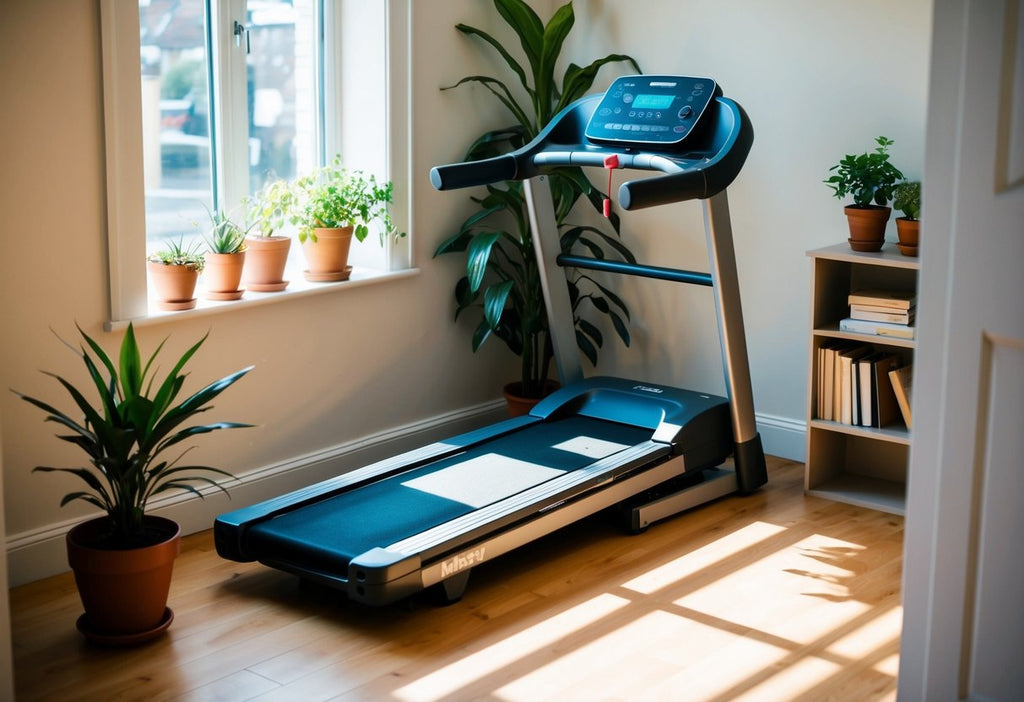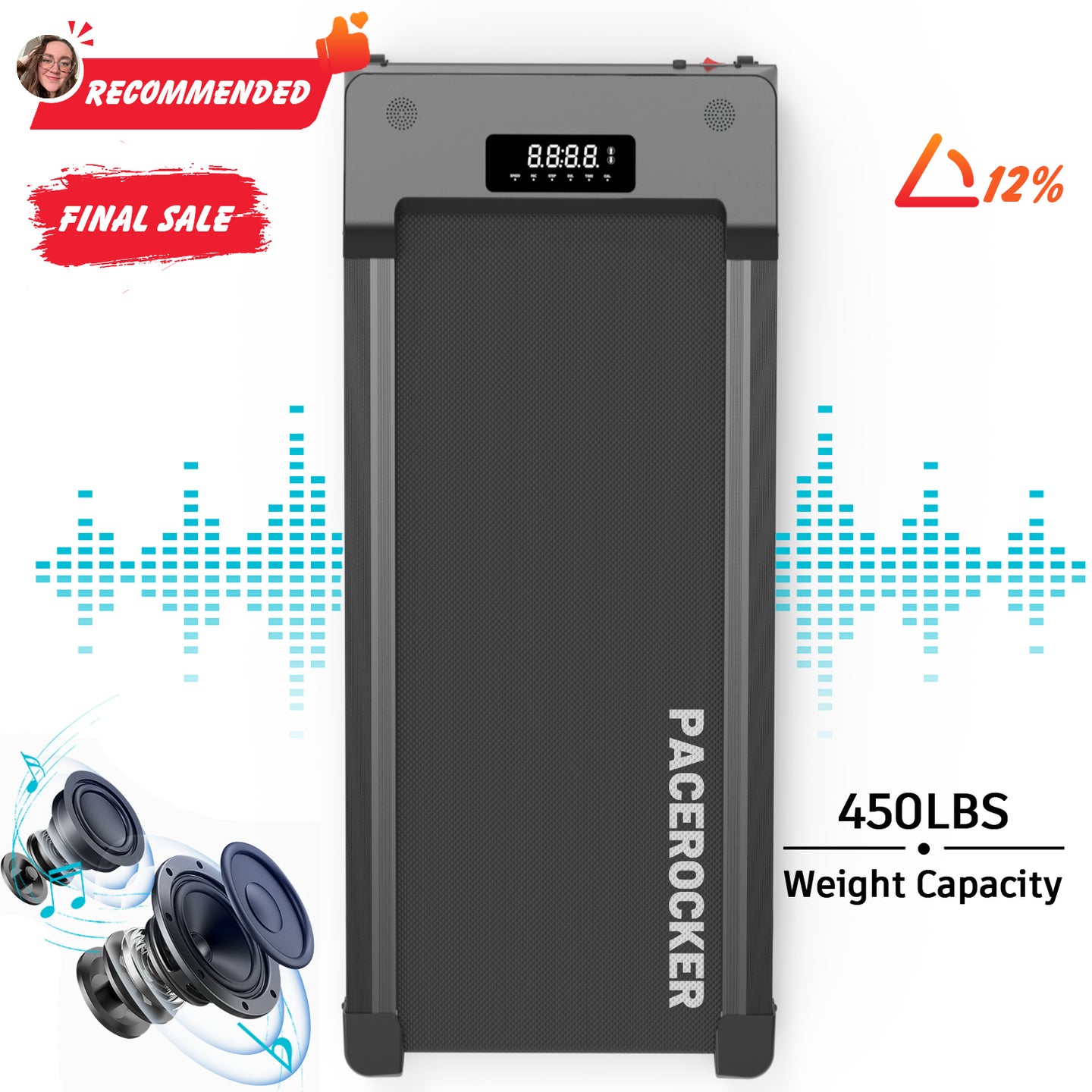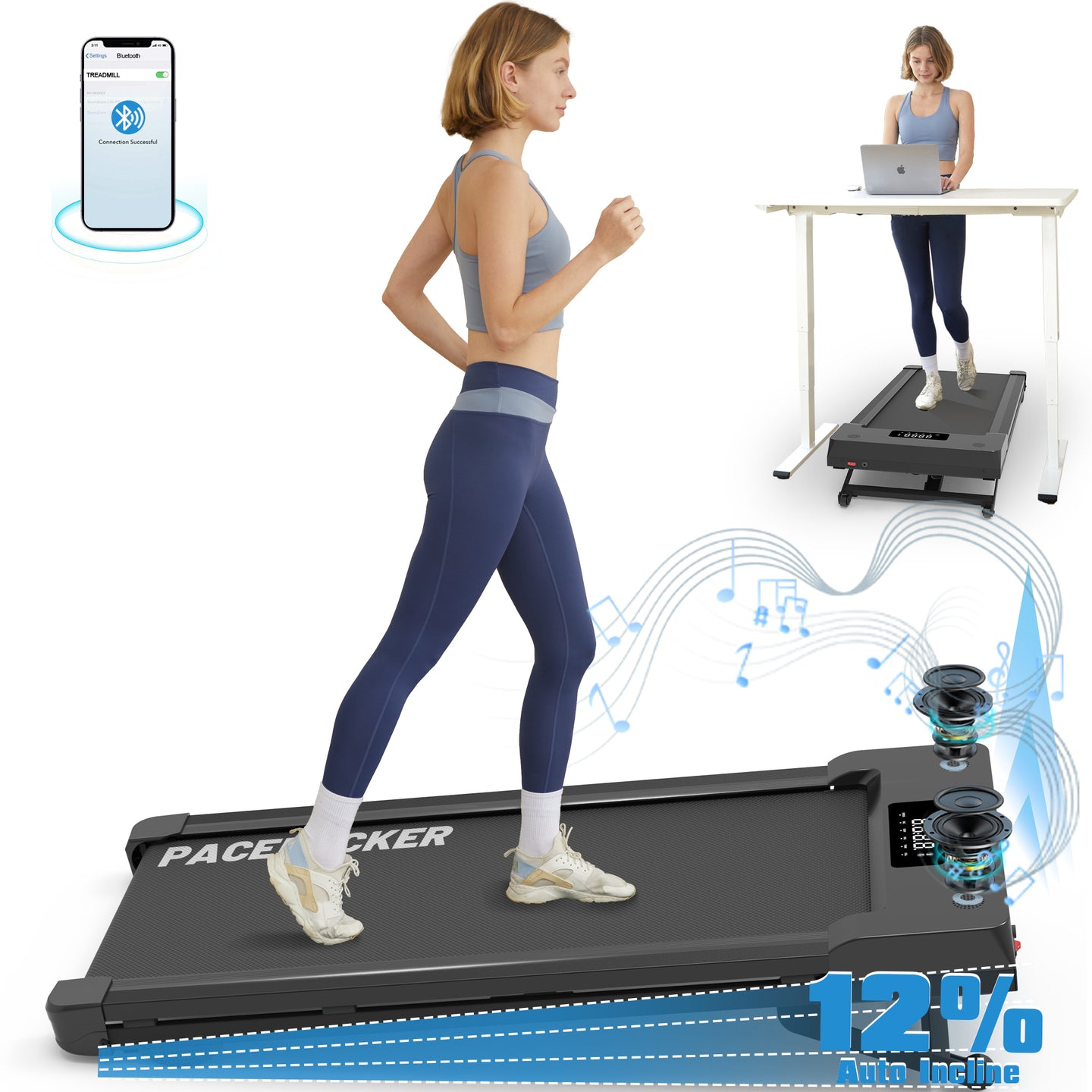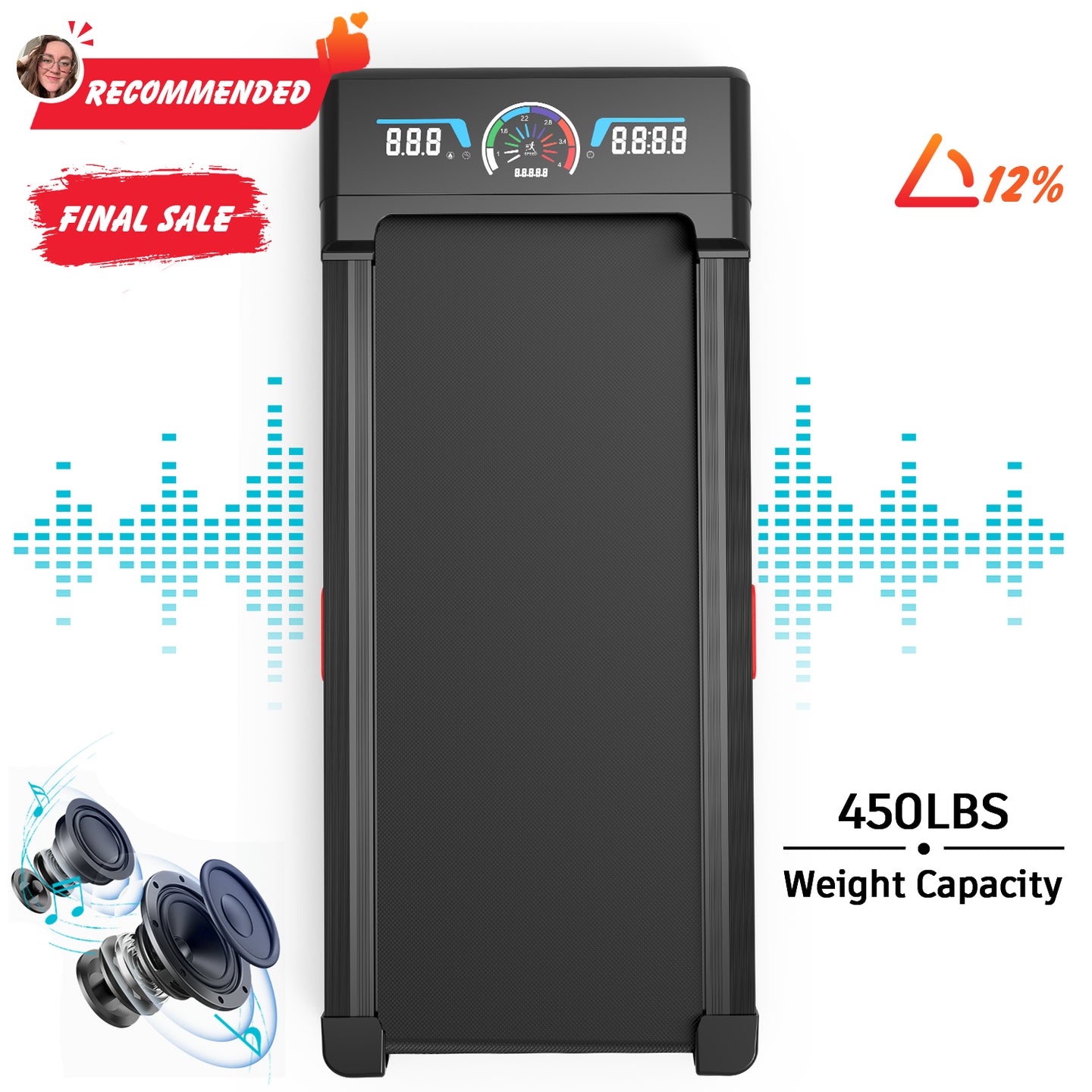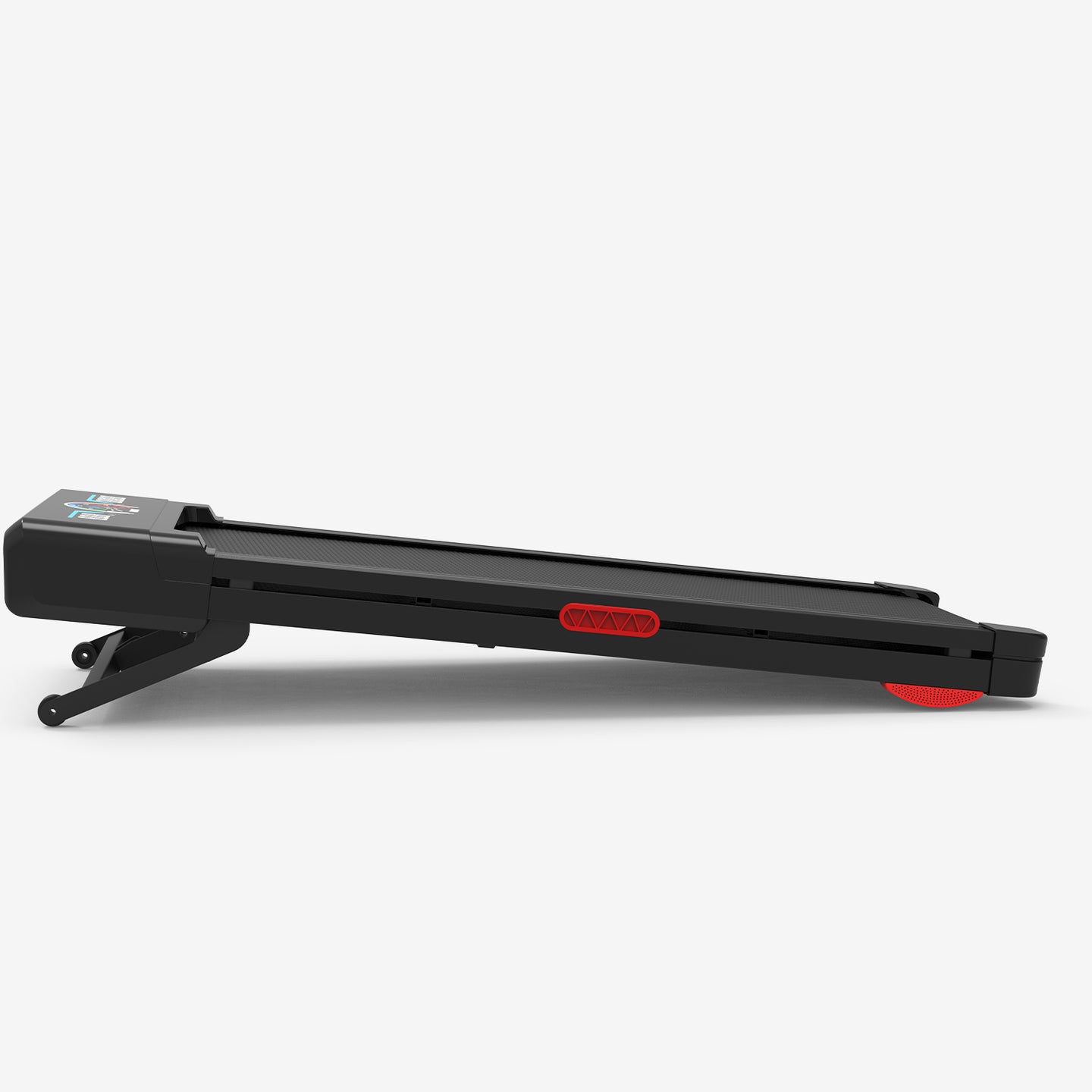Integrating Walking Pad Treadmills into Corporate Wellness Programs
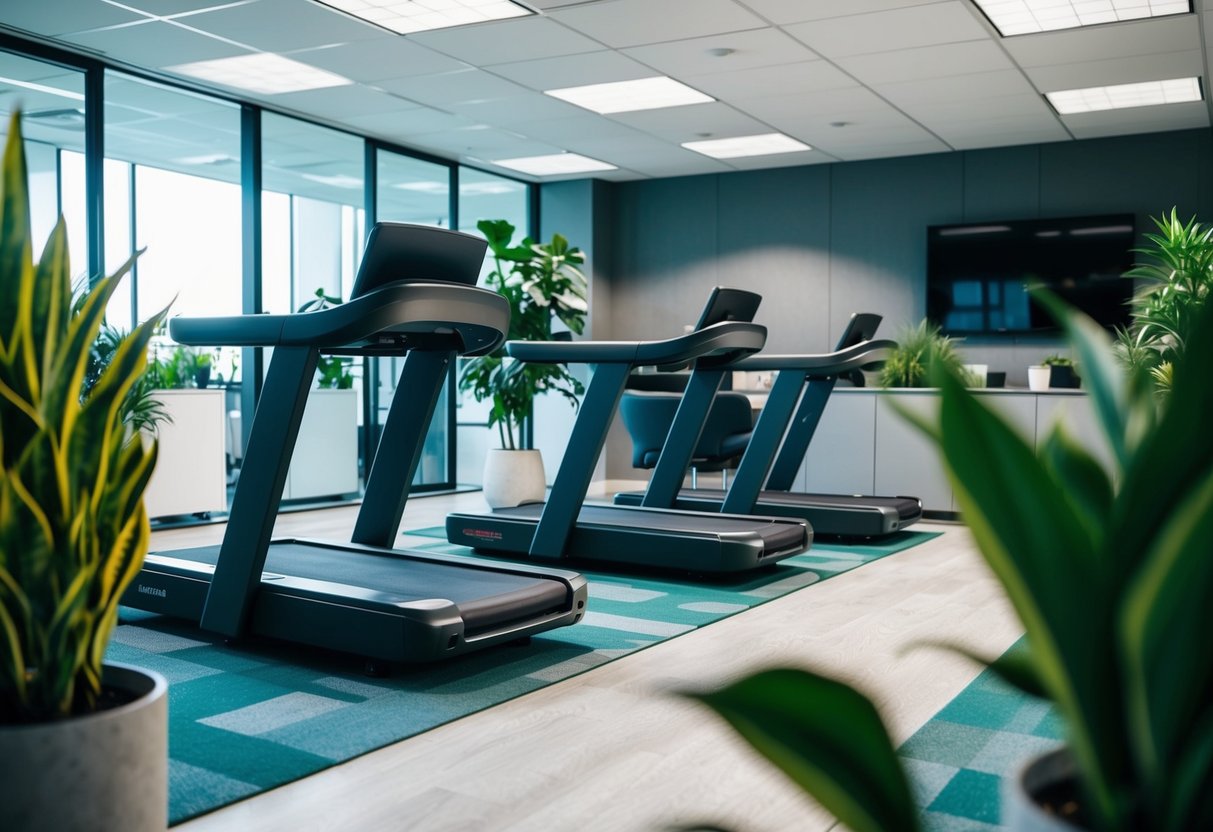
Don’t forget to check out our Pacerocker, Trailviber, and Trailviber Auto Incline walking pad treadmills.
Walking pad treadmills are revolutionizing corporate wellness programs across the globe. These compact, portable devices offer a unique solution for companies looking to boost employee health and productivity without sacrificing valuable office space.
By integrating walking pad treadmills into the workplace, companies can create a dynamic environment that encourages movement throughout the day, leading to improved physical health, mental well-being, and overall job satisfaction.
We've seen firsthand how these innovative treadmills can transform sedentary work cultures into vibrant, active spaces. Employees can take walking meetings, catch up on emails while strolling, or simply enjoy a quick energy boost between tasks. The versatility of walking pad treadmills makes them an ideal fit for various office layouts and work styles.
Implementing a walking pad program doesn't have to be complicated or expensive. With careful planning and employee input, companies can develop strategies that seamlessly incorporate these devices into daily routines. From dedicated treadmill zones to shared equipment systems, there are numerous ways to make walking at work both accessible and appealing.
Key Takeaways
- Walking pad treadmills boost employee health and productivity in the workplace
- Careful planning ensures successful integration of treadmills into office routines
- Employee engagement and feedback are crucial for program success and improvement
The Role of Walking Pad Treadmills in Corporate Wellness
Walking pad treadmills are transforming corporate wellness programs. These compact, portable devices offer employees an easy way to stay active during the workday without leaving their desks.
Benefits of Walking Pad Treadmills
Walking pad treadmills boost employee health and productivity. They allow for light exercise while working, reducing sedentary behavior. We've seen improved focus and energy levels among users.
These devices are quiet and unobtrusive, fitting seamlessly into office environments. They're perfect for conference calls or desk work. Many employees report reduced stress and better mood after using them.
Walking pads also promote better posture and help alleviate back pain. They're an excellent option for those with limited mobility or who find traditional exercise challenging.
Comparison with Traditional Exercise Equipment
Walking pad treadmills offer unique advantages over traditional gym equipment. They're more space-efficient and cost-effective for offices. Unlike bulky treadmills or stationary bikes, walking pads can be stored under desks.
We've found they encourage more consistent daily movement. Employees are more likely to use them regularly due to convenience. Traditional equipment often requires dedicated workout time, which can be hard to schedule.
Walking pads are also more inclusive. They accommodate various fitness levels and don't intimidate novice exercisers. This makes them ideal for company-wide wellness initiatives.
-
Pros of walking pads:
- Space-saving
- Low-impact exercise
- Can be used while working
- Quiet operation
-
Cons of traditional equipment:
- Requires dedicated space
- Often unused after initial enthusiasm
- Can be noisy and disruptive
Designing a Walking Pad Program
Creating an effective walking pad program requires careful planning and consideration of employee needs. We'll explore key steps to implement a successful initiative that promotes health and productivity.
Assessing Employee Needs and Wellness Goals
We start by surveying our staff to gauge interest and expectations. This helps us tailor the program to their specific needs. We gather data on current fitness levels, health concerns, and desired outcomes.
A questionnaire can uncover preferences for solo or group activities. We also inquire about preferred times for walking sessions - before work, during breaks, or after hours.
By analyzing this information, we can set realistic goals and create a program that resonates with our team. This personalized approach increases participation and long-term engagement.
Choosing the Right Models
Selecting appropriate walking pad models is crucial for program success. We consider factors like noise levels, size, and durability when making our choices.
Key features to evaluate:
- Speed range
- Weight capacity
- Folding capabilities
- Remote control options
- Safety features
We opt for models with quiet motors to minimize disruption in the office. Compact, foldable designs are ideal for spaces with storage limitations.
It's wise to test several options before making a bulk purchase. We can arrange trials with different manufacturers to find the best fit for our workplace.
Space Planning for Walking Pads
Integrating walking pads into our office layout requires thoughtful space planning. We identify areas that can accommodate the equipment without impeding workflow or creating safety hazards.
Potential locations include:
- Unused corners in open office areas
- Dedicated wellness rooms
- Near windows for natural light and views
- Adjacent to break areas for easy access
We ensure proper ventilation and consider power outlet availability. Installing anti-fatigue mats around the walking pads can provide additional comfort and safety.
Clear signage and usage guidelines help maintain order and prevent conflicts. We also create a booking system if demand exceeds the number of available units.
Integration Strategies
Implementing walking pad treadmills in corporate wellness programs requires careful planning and execution. We've outlined key strategies to help companies seamlessly incorporate these devices into their workplace.
Developing a Usage Schedule
Creating an effective usage schedule is crucial for maximizing the benefits of walking pad treadmills. We recommend setting up a booking system where employees can reserve time slots. This ensures fair access and prevents overcrowding.
Consider dividing the workday into 30-minute sessions, allowing for quick transitions between users. Encourage employees to book regular slots to establish a consistent routine.
It's also wise to designate certain hours for group activities or team-building exercises using the treadmills. This fosters a sense of community and motivation among coworkers.
Guidelines for Safe and Effective Use
Safety is paramount when integrating walking pad treadmills into the workplace. We suggest creating a comprehensive set of guidelines for all users to follow.
Key points to include:
- Proper posture and walking technique
- Speed limits (typically 1-4 mph for office use)
- Recommended duration of use (15-30 minutes per session)
- Appropriate footwear and clothing
- Rules for multitasking while walking
Provide a brief training session for new users to familiarize them with the equipment and safety protocols. Consider appointing wellness champions to assist colleagues and promote safe usage.
Maintenance and Upkeep
Regular maintenance is essential to keep walking pad treadmills in top condition. We advise creating a maintenance schedule and assigning responsibility to specific team members or the facilities department.
Daily tasks:
- Wipe down surfaces with disinfectant
- Check for any loose parts or unusual noises
- Ensure proper lubrication of the belt
Weekly tasks:
- Deep clean the treadmill and surrounding area
- Inspect power cords and connections
- Test emergency stop features
Monthly tasks:
- Tighten and adjust the walking belt
- Check and replace worn parts if necessary
- Update software if applicable
By following these maintenance guidelines, we can extend the lifespan of the equipment and ensure a safe, enjoyable experience for all users.
Measuring Success
Tracking the impact of walking pad treadmills on employee wellness is crucial for optimizing corporate programs. We'll explore key performance indicators, data analysis methods, and feedback loops to ensure continuous improvement.
Setting KPIs for Wellness Outcomes
We recommend establishing clear, measurable KPIs to gauge the effectiveness of walking pad initiatives. These might include:
- Daily active minutes per employee
- Average steps taken during work hours
- Reduction in sedentary time
- Improved employee satisfaction scores
It's important to align these metrics with broader company health goals. We've found that tracking changes in absenteeism rates and productivity levels can provide valuable insights into program success.
Data Collection and Analysis
Gathering accurate data is essential for meaningful analysis. We suggest:
- Integrating fitness trackers with walking pad systems
- Conducting regular health assessments
- Implementing user surveys to capture qualitative feedback
Advanced analytics tools can help identify trends and correlations. We've seen companies successfully use dashboards to visualize progress and motivate employees.
Regular Feedback and Program Adjustments
Continuous improvement relies on timely feedback and agile adjustments. We recommend:
- Monthly check-ins with participating employees
- Quarterly review meetings with wellness committees
- Piloting new features or challenges based on user suggestions
By staying responsive to employee needs, we can refine the program for maximum impact. It's crucial to celebrate successes and address concerns promptly to maintain engagement and enthusiasm.
Promoting Employee Engagement
Successful integration of walking pad treadmills into corporate wellness programs hinges on effective employee engagement strategies. We've found several key approaches that boost participation and create lasting culture change.
Incentivizing Participation
We recommend offering tangible rewards to motivate employees. Some effective incentives include:
- Fitness tracking devices or smartwatches
- Gift cards to sporting goods stores
- Extra vacation days for hitting step goals
- Discounts on health insurance premiums
Financial incentives can be powerful motivators. We've seen companies offer cash bonuses or contributions to health savings accounts for employees who consistently use walking pads.
Team-based challenges often spark friendly competition. Leaderboards displaying individual or department step counts can fuel motivation. Prizes for top performers or most improved teams add excitement.
Creating a Culture of Health and Fitness
Leadership buy-in is crucial for fostering a fitness-focused environment. When executives visibly use walking pads, it normalizes the practice.
We encourage designating "walking meetings" where teams use treadmills while collaborating. This shows that movement is valued during work hours.
Integrating walking pads into common areas creates opportunities for casual exercise. Placing them near break rooms or collaborative spaces increases visibility and accessibility.
Celebrating milestones reinforces positive habits. We suggest acknowledging employees who reach step goals or consistently use walking pads. Simple recognition like certificates or announcements in company newsletters can be highly motivating.
Communicating the Benefits to Employees
Clear, consistent messaging about walking pad benefits is key. We recommend creating eye-catching infographics highlighting health improvements and productivity gains.
Regular "health tip" emails can educate employees on the advantages of regular movement. Topics might include:
- Improved cardiovascular health
- Increased energy and focus
- Stress reduction
- Better posture and reduced back pain
Lunch-and-learn sessions led by health professionals can provide in-depth information. These events allow employees to ask questions and learn proper walking pad techniques.
Success Stories and Testimonials
Personal accounts from colleagues are powerful motivators. We suggest featuring employee testimonials in company newsletters or on internal message boards.
Before-and-after stories showcasing health improvements resonate strongly. Examples might include:
- Weight loss achievements
- Reduced blood pressure or cholesterol levels
- Increased daily step counts
- Improved mood and energy levels
Video testimonials can be particularly impactful. Short clips of employees discussing how walking pads have positively affected their workday can inspire others to try them.
Quantitative data adds credibility to success stories. We recommend sharing aggregate statistics on improved health metrics or reduced absenteeism rates since implementing the walking pad program.
Legal and Safety Considerations
Implementing walking pad treadmills in corporate wellness programs requires careful attention to legal and safety aspects. We'll explore key regulations and liability considerations to ensure a smooth integration.
Compliance with Health and Safety Regulations
Workplace safety laws vary by country and state, so we must research local requirements. In the US, OSHA standards apply to treadmill use in offices. We need to ensure proper spacing around equipment and clear emergency exit paths.
Regular maintenance checks are crucial. We recommend creating a log to track inspections and repairs. This helps demonstrate due diligence if issues arise.
Employee training is essential. We should develop a brief safety course covering proper use, emergency procedures, and ergonomic best practices. Documenting attendance can help mitigate liability risks.
Liability Issues and Insurance
Walking pad treadmills introduce new liability concerns for businesses. We suggest consulting with legal counsel to review and update workplace safety policies.
Liability waivers can offer some protection, but they're not foolproof. We recommend having employees sign acknowledgment forms after safety training.
Insurance is a must. We need to check if existing policies cover treadmill-related incidents. If not, additional coverage may be necessary. Some insurers offer specific plans for workplace wellness programs.
Clear signage near treadmills can reinforce safety guidelines. We should post visible warnings about potential risks and proper usage instructions.
Implementation Timeline and Milestones
We've crafted a strategic timeline to seamlessly integrate walking pad treadmills into corporate wellness programs. Our plan spans six months, broken down into key phases and milestones.
Month 1: Research and Planning
- Survey employee interest
- Identify potential walking pad suppliers
- Draft initial budget proposal
Month 2: Procurement and Space Allocation
- Select and order walking pad treadmills
- Designate appropriate office areas for installation
- Begin employee education on benefits and usage
Month 3: Installation and Testing
- Set up walking pads in designated spaces
- Conduct safety checks and test equipment
- Train HR and facility staff on maintenance
Month 4: Soft Launch and Feedback
- Introduce walking pads to a pilot group
- Gather initial user feedback
- Make necessary adjustments based on early experiences
Month 5: Full Implementation
- Roll out walking pads company-wide
- Host orientation sessions for all employees
- Implement a booking system for fair usage
Month 6: Evaluation and Optimization
- Analyze usage data and employee feedback
- Assess impact on productivity and well-being
- Plan for potential expansion or modifications
We'll track progress through bi-weekly check-ins and monthly progress reports. Our goal is to create a smooth transition that encourages widespread adoption and maximizes the benefits of this innovative wellness initiative.
Budgeting and Cost Management
Implementing walking pad treadmills in corporate wellness programs requires careful financial planning. We'll explore key budgeting aspects, from calculating ROI to identifying long-term savings.
Calculating Return on Investment
To justify the investment in walking pad treadmills, we need to crunch the numbers. We'll start by tallying the upfront costs, including equipment purchase, installation, and any necessary office modifications.
Next, we'll estimate the potential benefits, such as reduced healthcare costs, increased productivity, and improved employee retention. These factors can be challenging to quantify, but industry benchmarks and case studies can provide guidance.
We recommend creating a spreadsheet to track expenses and projected savings over a 3-5 year period. This will help visualize the break-even point and long-term financial impact.
Exploring Financing Options
There are several ways to fund walking pad treadmill programs without straining company budgets. Leasing options can spread costs over time, making implementation more manageable.
Some health insurance providers offer wellness program incentives or discounts that can offset expenses. It's worth reaching out to your company's insurance representative to explore these possibilities.
We've also seen success with employee cost-sharing models, where staff contribute a small amount towards equipment use. This can increase buy-in and help cover ongoing maintenance costs.
Grant programs focused on workplace health initiatives are another avenue to explore. Many local and national organizations offer funding for innovative wellness solutions.
Long-Term Cost Savings
While the initial investment may seem significant, walking pad treadmills can lead to substantial savings over time. Reduced absenteeism is a major factor – healthier employees take fewer sick days.
Lower healthcare costs are another benefit. Regular exercise can help prevent chronic conditions, potentially reducing insurance premiums and out-of-pocket expenses for both the company and employees.
We've observed increased productivity among walking pad users. The ability to move while working can boost energy levels and focus, leading to more efficient task completion.
Employee retention improvements shouldn't be overlooked. Offering unique wellness benefits like walking pads can make your company more attractive to current and prospective employees, reducing costly turnover.
Sustainable Practices and Environmental Impact
Walking pad treadmills offer an eco-friendly alternative for corporate wellness programs. We've found these compact devices consume less energy than traditional treadmills, reducing the overall carbon footprint of office fitness initiatives.
Many models are made with recyclable materials, aligning with companies' sustainability goals. Their smaller size also means less waste when it's time to replace them.
Walking pads encourage employees to move more throughout the day. This can lead to decreased reliance on elevators and less frequent car use for short trips, indirectly lowering emissions.
Some manufacturers have implemented take-back programs, ensuring proper recycling of old units. This circular approach supports businesses in meeting their environmental targets.
Energy-efficient walking pads often come with power-saving modes. These features automatically shut off the device when not in use, further minimizing unnecessary electricity consumption.
By choosing walking pads, companies demonstrate their commitment to both employee health and environmental stewardship. It's a win-win for wellness and sustainability initiatives.
Employee Feedback and Continual Improvement
Regular input from employees helps shape and refine walking pad programs. We gather insights through surveys and adapt initiatives based on participant experiences.
Surveys and Employee Input
We distribute quarterly surveys to gather employee feedback on our walking pad program. These questionnaires cover usage frequency, perceived benefits, and suggestions for improvement. Face-to-face interviews with a sample of participants provide deeper insights into individual experiences.
Anonymous suggestion boxes placed near walking pad stations encourage ongoing feedback. We also monitor usage data from the treadmills to identify peak times and underutilized periods.
Monthly focus groups bring together employees from different departments to discuss the program's impact on their work-life balance and productivity.
Adapting the Program Based on Feedback
We review all collected feedback monthly to identify trends and areas for enhancement. Common requests, like adjusting walking pad locations or adding features, are prioritized for implementation.
Our IT team works on integrating popular fitness apps with the walking pads based on employee suggestions. We've introduced team challenges and leaderboards to boost engagement after noticing a desire for more social elements.
Feedback-driven improvements include installing privacy screens around some units and offering noise-canceling headphones for a better experience. We continuously refine our wellness workshops to address frequently asked questions about ergonomics and proper walking pad use.
Frequently Asked Questions
Walking pad treadmills offer numerous advantages for corporate wellness programs. Let's address some common queries about their implementation and benefits in the workplace.
What are the tangible benefits of incorporating walking pad treadmills into our office routine?
Walking pad treadmills boost physical activity during the workday. They help reduce sedentary behavior, improve circulation, and increase energy levels.
We've seen employees report reduced back pain and improved posture. These treadmills also contribute to better weight management and cardiovascular health.
How does the use of walking pad treadmills enhance employee productivity and well-being?
Regular movement stimulates brain function and creativity. Employees often report increased focus and alertness when using walking treadmills.
We've noticed improved mood and reduced stress levels among staff. The combination of physical activity and work tasks can lead to more efficient time management.
Can walking pad treadmills be easily integrated into various work environments and spaces?
Absolutely! Walking pad treadmills are designed to be compact and portable. They fit well under standing desks or in small office spaces.
We've successfully incorporated them into open-plan offices, private cubicles, and even meeting rooms. Their quiet operation ensures minimal disruption to coworkers.
Are there success stories or case studies of businesses that effectively implemented walking treadmills in the workplace?
Several tech companies in Silicon Valley have reported positive outcomes. One firm saw a 15% increase in employee satisfaction after introducing walking treadmills.
We know of a marketing agency that experienced a 10% boost in creative output. A law firm noted improved employee retention rates following treadmill implementation.
What is the best approach to encourage staff participation and regular use of walking pad treadmills?
Start with a pilot program and gather feedback. Offer training sessions to familiarize employees with the equipment.
We recommend creating challenges or competitions to spark interest. Providing flexible scheduling for treadmill use can also increase participation.
How do we measure the impact of walking pad treadmills on overall corporate wellness?
Track key metrics like absenteeism rates, health insurance claims, and productivity levels. Conduct regular surveys to gauge employee satisfaction and perceived health benefits.
We suggest monitoring treadmill usage data and correlating it with wellness program goals. Analyzing these factors over time will reveal the program's effectiveness.
Boost corporate health and productivity with walking pad treadmills! Discover how compact treadmills enhance work environments without taking up space.


